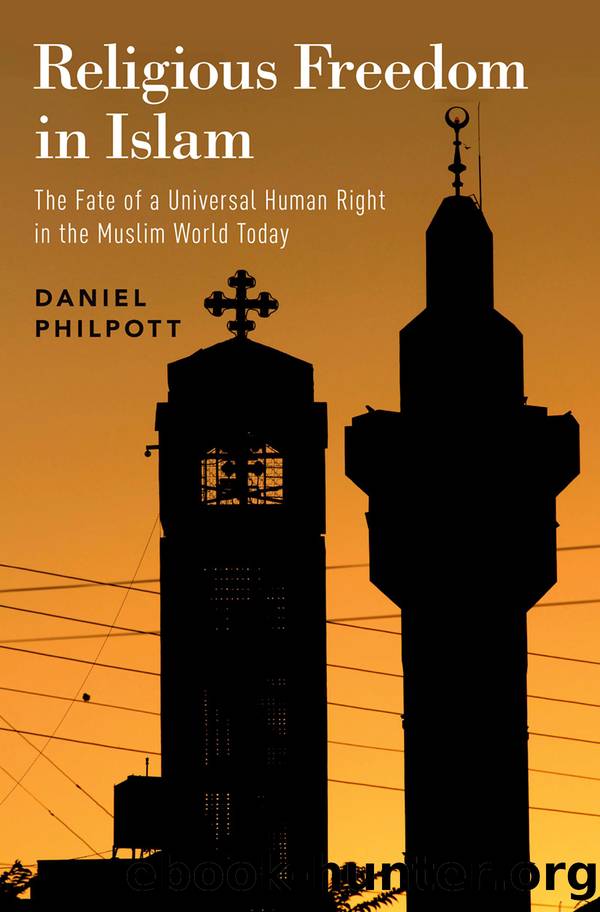Religious Freedom in Islam by Philpott Daniel;

Author:Philpott, Daniel; [Philpott, Daniel;]
Language: eng
Format: epub
ISBN: 9780190908188
Publisher: OxfordUP
Published: 2019-09-15T00:00:00+00:00
5
The Arab Uprisings
at 11:30 in the morning of December 17, 2010, Mohamed Bouazizi, a produce vendor in the city of Sidi Bouzid, Tunisia, set himself on fire in front of the local government headquarters. Twenty-six years old, Bouazizi had sold fruits and vegetables to support his extended family, including six siblings, in this rural town that suffered from corruption and an unemployment rate of 30%. According to a close friend, Bouazizi was well liked and known for giving produce to the poor without charge.
Earlier that morning, a female city employee, Faida Hamdi, had confiscated Bouaziziâs produce cart and his weighing scale, explaining that Bouazizi had lacked a vendorâs license. Bouazizi had suffered such treatment many times before but offered to pay a fine. What happened next is disputed, but Hamdi is alleged to have refused his payment, struck him, spat on him, and, when he resisted, called the police, who then beat him. Outraged, Bouazizi went to the provincial headquarters to complain but was refused a hearing. Then, standing in the middle of traffic outside, he doused himself with gasoline and lit himself on fire. Eighteen days later, on January 4, 2011, he died in the hospital.
Had Bouaziziâs story ended there it would have remained little more than a tragic commentary on corruption and economic stagnation in Tunisia under the dictatorship of President Zine El Abidine Ben Ali. Instead it provoked a historic wave of demonstrations and uprisings across the entire Arab world. Within hours, protests began in Sidi Bouzid and then spread quickly to all of Tunisia, facilitated by Facebook and other social media. On January 14, 2011, President Ben Ali fled the country with his family and took refuge in Saudi Arabia, where he resigned and ended his 23-year reign. Soon thereafter, Egyptians took to the streets to protest the rule of President Hosni Mubarak, who ended his own 30-year reign when he resigned the next month. Uprisings also broke out in Bahrain, Yemen, Libya, and Syria, and large-scale protests took place in Algeria, Iraq, Jordan, Kuwait, Morocco, and Sudan.
Did the Arab Uprisings succeed? If success means overthrowing a dictator, then uprisings succeeded in four countriesâout of six countries in which major uprisings took place (Tunisia, Egypt, Libya, Yemen, Bahrain, and Syria) and out of 14 Arab states that were autocracies and free from foreign occupation and thus ripe for popular challenge.1 One of the four ousters, that of Muammar Qaddafi in Libya, required air strikes from the worldâs most powerful military alliance, NATO. In Bahrain, the regime survived through cracking down on the protests with the help of Saudi Arabian troops who crossed the causeway that connects the two countries. Syriaâs regime has survived overthrow as well but only through a civil war that has killed more than 300,000 people by conservative estimates, displaced some 6.6 million internally, and created 4.8 million refugees outside Syria.2 All in all, around 90,000 people died across 16 countries where interconnected protests and uprisings took place over the 30 months following Mohamed Bouaziziâs self-immolation.
Download
This site does not store any files on its server. We only index and link to content provided by other sites. Please contact the content providers to delete copyright contents if any and email us, we'll remove relevant links or contents immediately.
| Hadith | History |
| Law | Mecca |
| Muhammed | Quran |
| Rituals & Practice | Shi'ism |
| Sufism | Sunnism |
| Theology | Women in Islam |
The History of Jihad: From Muhammad to ISIS by Spencer Robert(2507)
Nine Parts of Desire by Geraldine Brooks(2281)
The Turkish Psychedelic Explosion by Daniel Spicer(2246)
The First Muslim The Story of Muhammad by Lesley Hazleton(2157)
The Essential Rumi by Coleman Barks(1930)
1453 by Roger Crowley(1881)
The Last Mughal by William Dalrymple(1790)
Trickster Travels: A Sixteenth-Century Muslim Between Worlds by Davis Natalie Zemon(1783)
Muhammad: His Life Based on the Earliest Sources by Martin Lings(1569)
by Christianity & Islam(1562)
God by Aslan Reza(1560)
A Concise History of Sunnis and Shi'is by John McHugo(1510)
Magic and Divination in Early Islam by Emilie Savage-Smith;(1455)
No God But God by Reza Aslan(1436)
The Flight of the Intellectuals by Berman Paul(1396)
Art of Betrayal by Gordon Corera(1365)
Nothing to Envy by Barbara Demick(1326)
What the Qur'an Meant by Garry Wills(1321)
Getting Jesus Right: How Muslims Get Jesus and Islam Wrong by James A Beverley & Craig A Evans(1275)
